USS Ranger (CV-4)
 USA (1933)
USA (1933)
WW2 US Carriers:
USS Langley | Lexington class | Akron class (airships) | USS Ranger | Yorktown class | USS Wasp | Long Island class CVEs | Bogue class CVE | Independence class CVLs | Essex class CVs | Sangamon class CVEs | Casablanca class CVEs | Commencement Bay class CVEs | Midway class CVAs | Saipan classUSS Ranger (CV-4) was the first USN aircraft carrier designed as such. She was a relatively light Treaty ship, with a displacement of only 15,000 long tons (15,000 t), and in her original guise was without an island superstructure. Her small size and low speed eliminated her from the Pacific Fleet and instead, she spent most of the war in the Atlantic, providing air support for Operation Torch, and serving as the operation leader off Norway among others. Throughout her service, she was too small to deploy an efficient air group, which was taken into account for the subsequent Yorktown class.
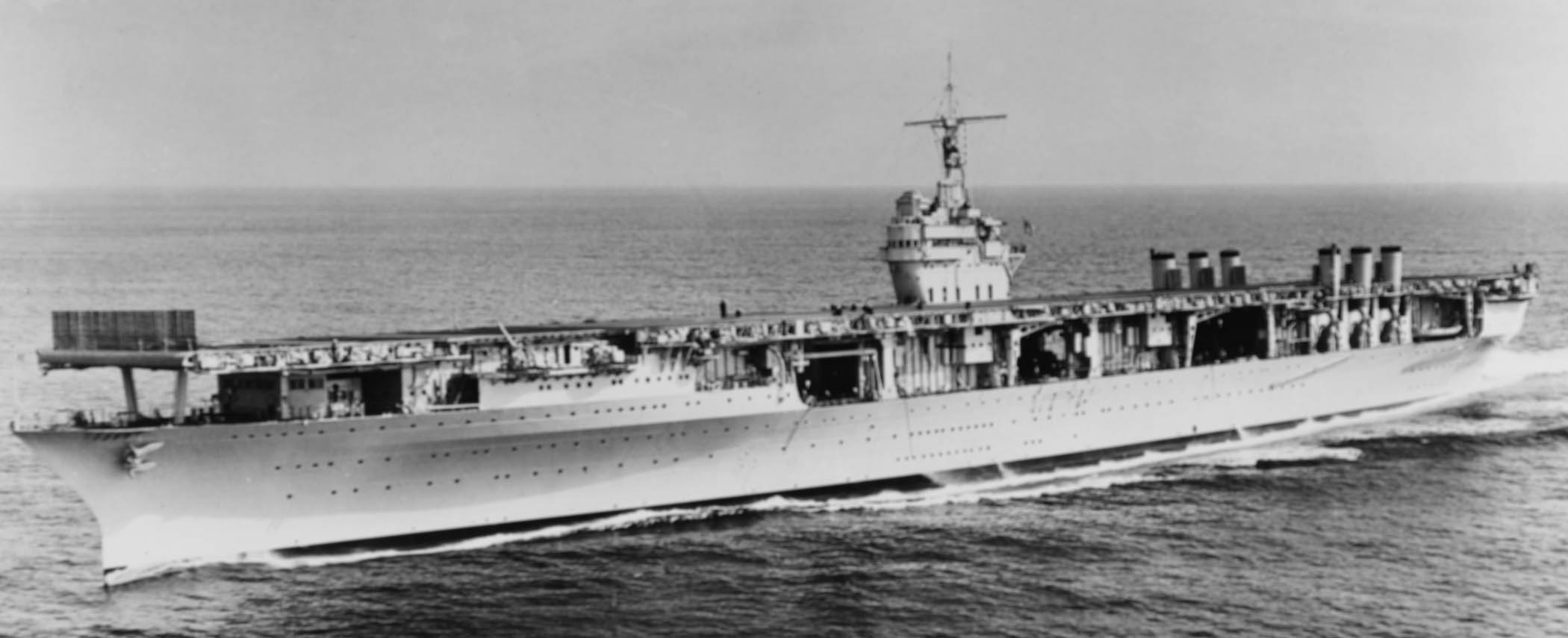
Design development
Her design work started in 1925. At the time, conversion work was still ongoing on the Lexington class carriers, and a fourth carrier was needed for the Navy. Until then, the only aircraft carrier in service was
the slow and small USS Langley, a converted collier. The Lexington and Saratoga were also converted ships but were based on battlecruisers, making the best of their size and speed. The hypothetical fourth Carrier was seen as an opportunity to create a carrier from scratch. Preliminary design work was mostly theoretical, as only the Langley was in service, and was at best a stopgap solution, whereas the more promising Lexingtons were far from completion (they would be finished in 1927). With this limited experience to draw on, characteristics were defined after reports from wargaming experience at the U.S. Naval War College. The initial design was ready in 1927, but many alterations would follow as a result of real-world experience gained through the newly launched Lexington and Saratoga.
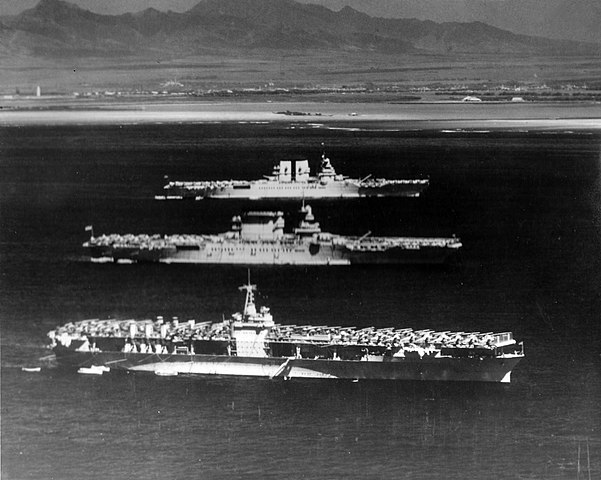
USS Ranger, Lexington and Saratoga
The Washington treaty CV’s displacement limits
There was, however, a major limitation to the admiralty’s ambitions for the new vessel regarding its size
and speed: The constraints of the Washington Naval Treaty signed in 1920. The Lexingtons displaced 69,000 long tons and ate a considerable part of the allowed tonnage for the "CV" category. This left room for three 23,000 long-ton carriers, four 17,250 ton carriers, and five 13,800 ton carriers, as calculated;
The smaller one, at 13,800 was selected first to rapidly ramp up the USN's carrier force. Wargames showed severe attrition of airframes and hulls and the Naval College recommended the USN cram as many aircraft as the hulls allowed. One of the key features of the design was the fact the hull was flush-decked to simplify the structure and the flying deck ended without an overhanging prow and stern. This flight deck was designed to be clear of obstacles, but this came with the drawback of complicating the machinery arrangements.
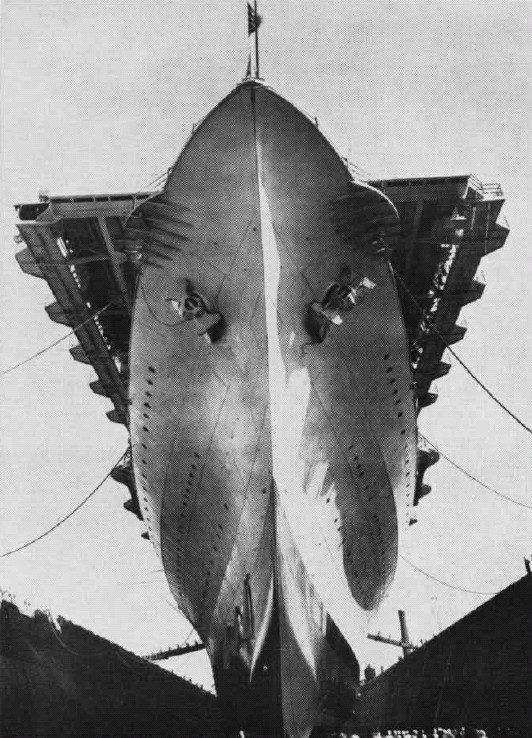
Ranger’s prow in drydock, 1937
The problem of smoke
To get rid of the smoke the solution was to truncate exhaust from the six boilers into a corresponding number of small stacks, three on either side of the aft hangar, that would be hinged to rotate parallel with the hangar deck. This setup was only used for flight operations. When the carrier was cruising, the funnels would angle back up to the verticle position.
In further pursuit of an uninhibited flight deck, the carrier was “headless”, without any island, and even when one was added, the funnels were not moved into the island as a cost-saving measure. The USN had learned with USS Langley that smoke dispersion was a major source of interference for air operations, and thus their implementations with the Ranger’s funnels impacted the propulsion design.
The powerplant management reflected this, with a particular placement of the boilers in order to decrease the amount of smoke generation. A relatively modest 53,000shp powerplant was chosen, small enough to be placed further aft, where a much larger power unit would not have fit. But it left little room for improvement on the ship without compromising her top speed.
These boilers had their stacks placed so as to disperse smoke over less of the deck's surface.
Propulsion-wise, due to further space issues, more compact geared turbines were installed.
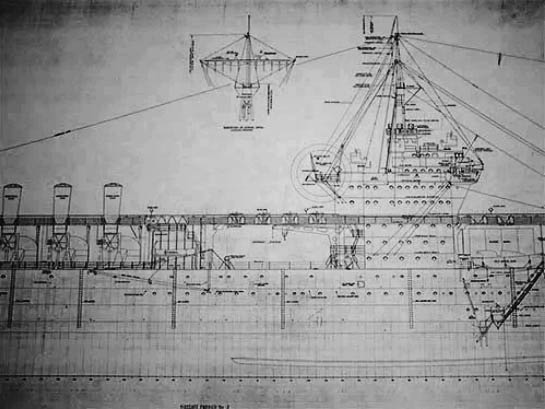
Original blueprint extract, island superstructure. Src
The Tour de Force: 76 aircraft on a small package
The upper deck was entirely covered by the hangar and made efficient use of the space. The high open girders of the flight deck structure made for a roomy space for plane storage. The hangar deck was semi-open however, with large roll-up metal curtain doors to divide the large space in case of fire, with the added benefit of temperature control. They were left open in summer or tropical waters and closed in bad weather. This was followed by the installation of two catapults on the hangar deck to launch observation aircraft, though they were later dropped as a cost-saving measure.
There was also a gallery deck between the flight deck and hangar deck. The latter was a light superstructure (for stability), sheathed in wood (for heat). It was found to be easy to maintain and repair but offered no protection. To serve the deck, three elevators were installed (the forward one, at the end of the flying deck, was later removed, leaving only the two large lifts amidship, offset to the right. Outriggers at the edge of the flight deck provided more space to stack aircraft on the deck, which was a novel feature at the time.
Between this long deck and roomy hangar, engineers managed to create enough stowage for up to 76 aircraft, equal to the much larger and costlier Lexington class, with just half the displacement. That capability was the
main tour de force of the design.
The onboard armament was also innovative: Rather than stacking heavy guns for self-defense, aviation was trusted enough to limit Ranger’s direct defense to lighter dual-purpose guns. Eight dual-purpose 5-inch (127 mm)/25 caliber guns, the same carried by cruisers of the time, were installed, in sponsons platforms fore and aft, and controlled by two Mark 33 directors. Dive-bombing attacks were feared, and so this was initially complemented by forty .50 cal machine guns placed along the gallery. After Pearl Harbor, this armament proved inadequate and in 1942, it was completely modernized with 20 mm Oerlikon guns.
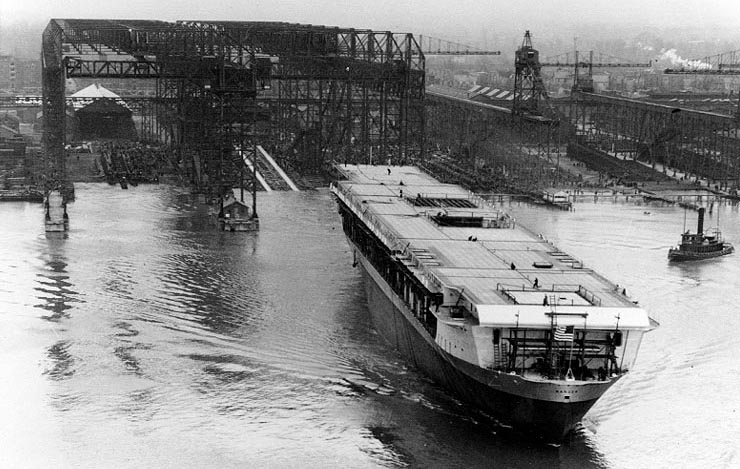
Launch of USS Ranger at Newport News, February 24, 1933
Final Design

Appearance in 1942 – Blueprint sold on EBay
As finalized, the initial design was submitted to bidders, and then authorized by Congress on 13 February
1929. Bids for her construction were opened by the Navy on 3 September 1930. After the selection, Newport News Shipbuilding won over Bethlehem Shipbuilding Corp. and New York Shipbuilding Co. In November 1929, Newport News Shipbuilding officially signed the contract, for 15.2 million dollars. On 10 December, the new carrier was named USS Ranger. This was an old name, already used by John Paul Jones’s sloop of war in 1777. The famous US Rangers inspired this name; they were a well-trained militia witch served in the 17th and 18th-century “Indian and French war” notably between American colonists and Native American tribes. The name was resurrected in WW2 for US Commandos.
Dimensions: As blueprints go, the USS Ranger was to be 14,700 tonnes, and after completion, she displaced 14,576 long tons (14,810 t) standard and 17,577 long tons (17,859 t) fully loaded. She
measured 730 ft (222.5 m) at the waterline and 769 ft (234.4 m) overall, for a 80 ft (24.4 m) beam at the
waterline and 109 ft 5 in (33.4 m) overall at the level of the deck gallery. Her draft was of 22 ft 4.875 in
(6.8 m).
Propulsion: The USS Ranger was driven by two shafts, which in turn were powered by two geared
steam turbines and fed by six boilers for a total output of 53,500 shp (39,900 kW) and a top speed of 29.3
knots (54.3 km/h; 33.7 mph). Her range was 10,000 nautical miles (19,000 km; 12,000 mi) at 15 knots (28
km/h; 17 mph).
Protection: It was limited to a 2 in (5.1 cm) thick belt with some ASW compartmentation behind but no longitudinal bulkhead. Internally, she had transverse bulkheads of 2 in (5.1 cm) too, and a partial armour deck of 1 in (2.5 cm) over the steering gear. The gasoline tanks and ammunition stores were not
protected.
Armament: Initially, she carried eight 5 in (127 mm)/25 cal anti-aircraft guns and 40 × .50 in (12.7 mm) machine guns in single overhanging positions along the decks, starboard, and port. This armament was
maintained until March 1942, but before that, a battery of 3-inch (76 mm)/50 caliber guns was installed, replaced later by 1.1-in quadruple mounts (40 mm). It was again modified in 1943 during the carrier’s major refit.
Air group
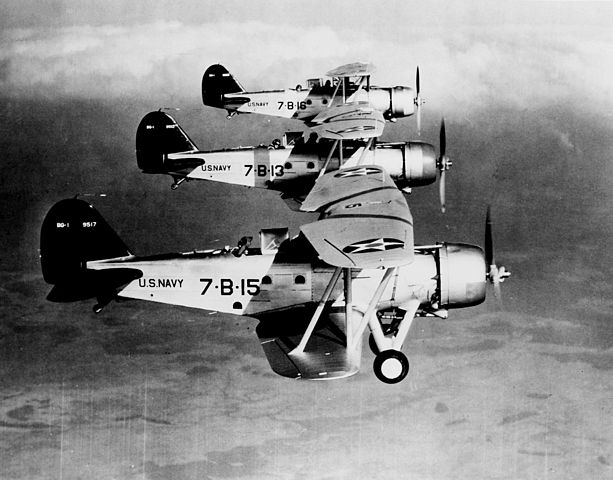
Great Lakes dive bombers in formation
Certainly, the most important part of her design: Although on paper her normal provision called for 76
aircraft, up to 86 could be carried, some suspended under the roof and partly dismounted, and on the
deck. It was hardly practical for operations. In practice, about 65 planes were considered ideal. In any
case, it diminished rapidly as planes grew larger. When USS Ranger was commissioned on 4 June 1934, she was given no torpedo stowage and no torpedo bomber squadron as a cost-saving measure.
It was not before 17 October 1941 that this issue was solved by authorizing a proper torpedo stowage during an
overhaul and giving her her first torpedo squadron, equipped with the Douglas TBD Devastators. On 10 January 1942, the torpedo Squadron 4 (VT-4) was activated.
As commissioned, USS Ranger carried the Curtiss BF2C-1 Goshawk fighter with the VB-5, replaced soon after by the Grumman FF. To complete her air wing, USS Ranger carried the Great Lakes BG dive bomber and a SOC Seagull for observation.
USS Ranger also evaluated the Curtiss F7C Seahawk, Northrop BT, and Vought SBU Corsair. From 1937, her fighters were replaced by the Grumman F3F and in 1938, the Vought SB2U Devastator replaced the Great Lakes BG. Of course, it would be evolved again in 1941, with the arrival of the first TB group of VT-4 equipped with the TBD Devastator while Grumann F4F Wildcat fighters replaced earlier F3F biplanes.
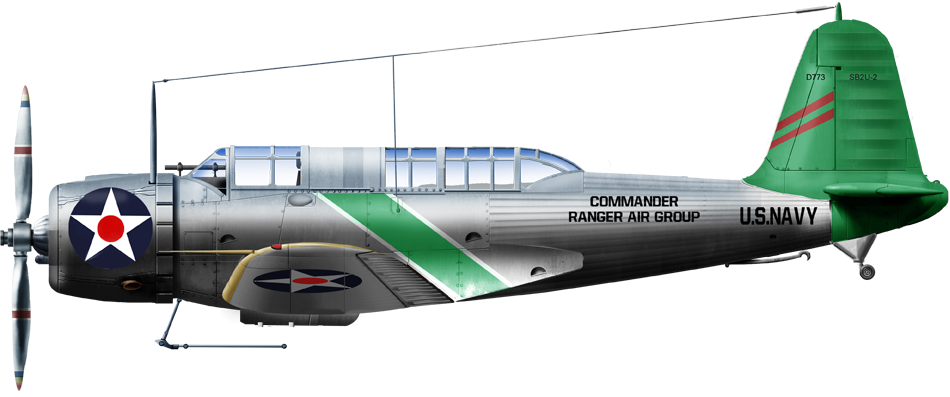
SB2U-1 of Air Group Commander USS Ranger 1940
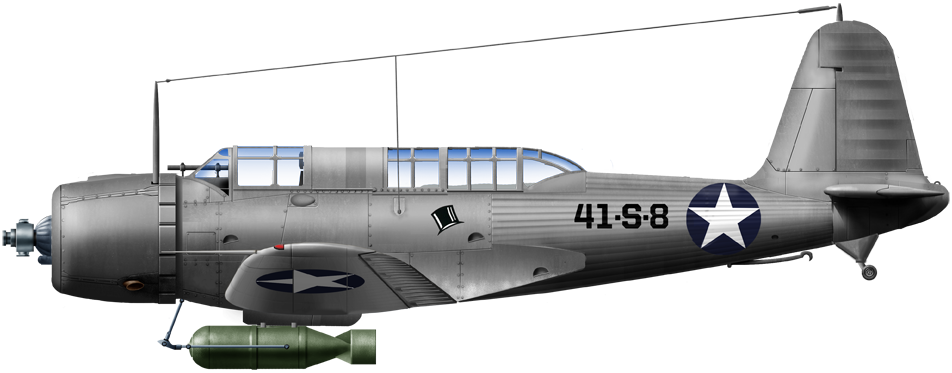
SB2U-3 of VS41 onboard USS Ranger, 1941
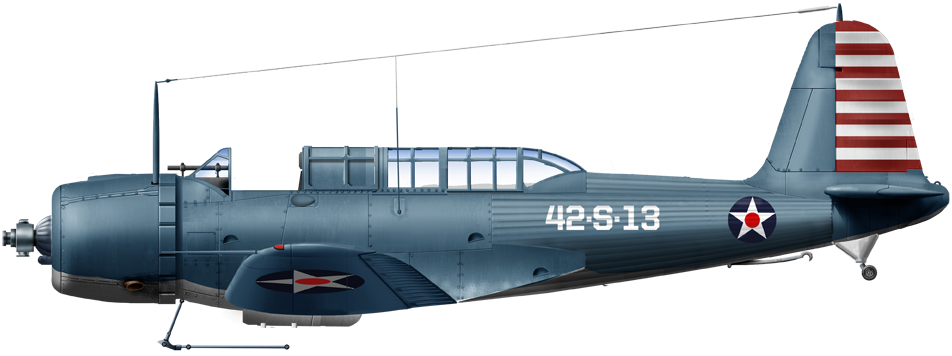
SB2U-2 of VS42 onboard USS Ranger, 1941
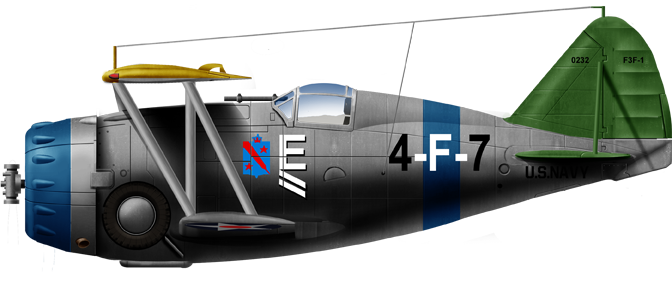
Grumman F3F-1 of VF-4 on board USS Ranger, 1940
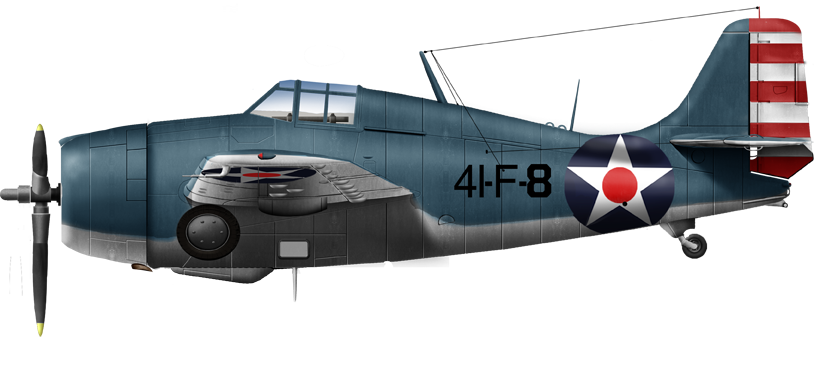
Grumman F4F3A of the VF41 on USS Ranger in early 1942. USS Ranger was the first USN carrier to receive the new fighter of the USN.
Construction
Newport News Shipbuilding in Virginia received 15.2 million dollars for the Ranger as part of the contract,
and she was laid down on 26 September 1931 and launched on 25 February 1933. That day, she was sponsored by Lou Henry Hoover, First Lady of the United States. The ship's island was only added during completion, and it added to the ship’s displacement, which brought it up to 14,500 tons. She started her early machinery trials on 1 May 1934, making 30.35 knots over an output of 58,700 shp. She was eventually commissioned at the Norfolk Navy Yard on 4 June 1934. Her first Captain was Arthur L. Bristol.
Interwar modifications
USS Ranger initially had an incomplete air group, missing the torpedo bombers and even installations and stowage of aerial torpedoes. From 17 October 1941 however, torpedo stowage was installed during the overhaul, but the vessel had to wait until 10 January 1942 for its first Torpedo Squadron VT-4 to be constituted. In 1941 also, Ranger’s 5-in guns were added. In 1942, six 1.1-in quad mounts were installed but replaced by 3-in (76 mm)/50 guns as placeholders. From March 1942, the .50 cal machine guns were deposed and all replaced by Oerlikon 20mm cannons (46 20mm mounts) while the 1.1-in battery was replaced by six quadruple Bofors 40mm guns in December 1942, two placed fore and aft of the island, two on the sides, and one at the stern and another at the prow.
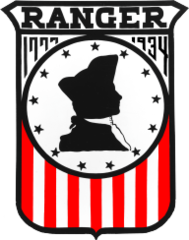
1943 modernization
On 13 December 1943, the Chief of Naval Operations Admiral Ernest King approved an extensive modernization of the Ranger. The size of carrier aircraft had become massive, and the tiny and narrow flight deck or the Ranger, at the time fit for the small and light biplanes of the time, was no longer relevant for a modern air group. To correct this, a long list of modifications were made:
-The aft elevator was enlarged and the amidship elevator was replaced with a deck-edge elevator
-Two flight deck catapults were installed.
-The hull was blistered to increase stability and ASW protection.
-Armament increased with six 40 mm quadruple mounts, including two fitted for and aft of the island.
-Additional 20 mm Oerlikon AA guns
-New radar and modernized electronics
Admiral King however met but the strong resistance of the Bureau of Ships, which insisted that manpower and resources would delay the precious completion of more capable Essex-class aircraft carriers then under construction. The project was postponed indefinitely by 5 April 1944 after a third estimate. However it was eventually approved and Ranger was in York Harbor on 16 May 1944, Norfolk Navy Yard for a partial application of the plan: She had her flight deck strengthened, the catapults installed and updated radar, notably to enable night fighter-interceptor training capabilities.
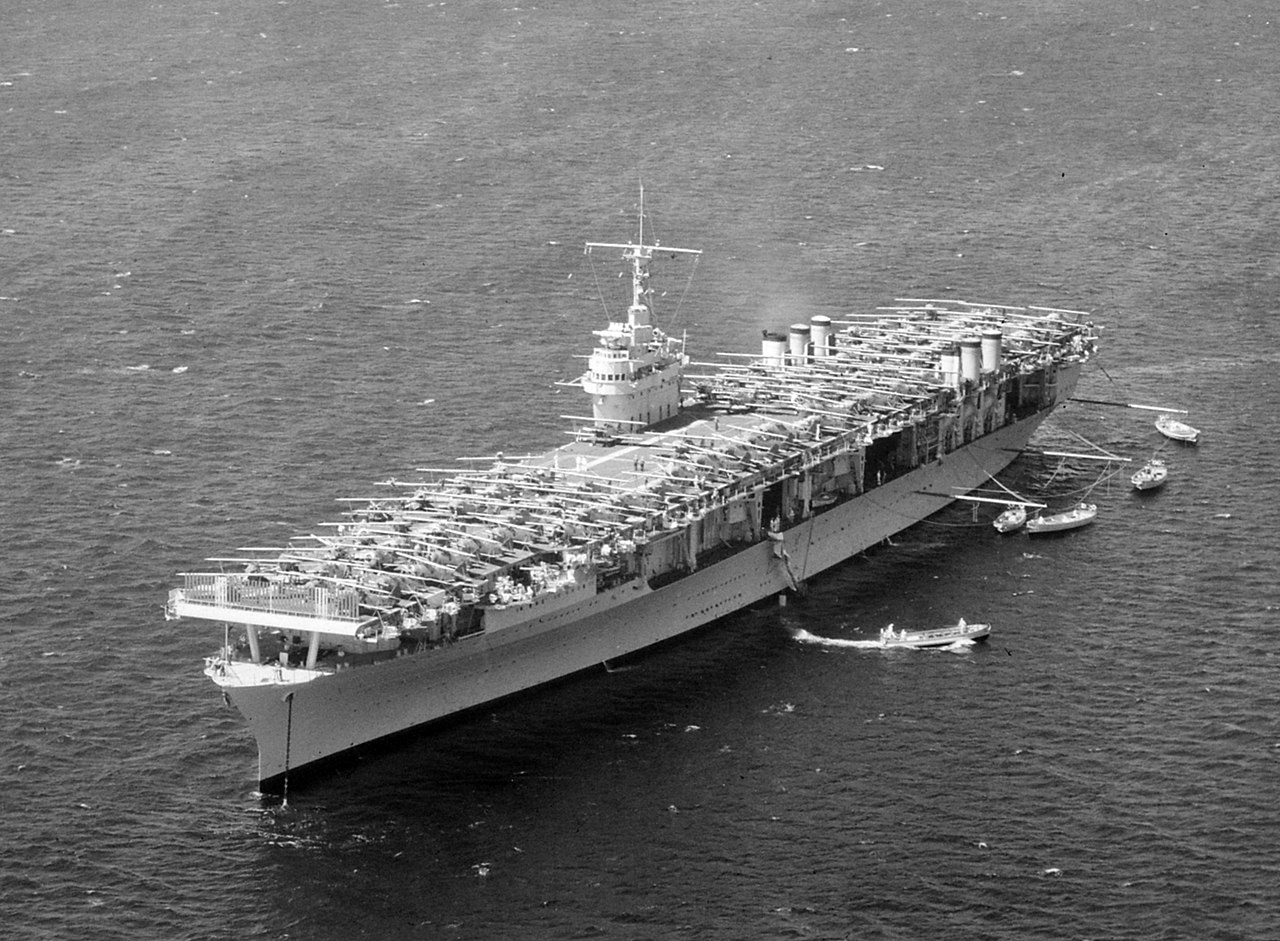
HD photo of the Ranger at anchor in 8 April 1938.
Specifications as completed |
|
| Dimensions | 730 ft (222.5 m) wl, 769 ft (234.4 m) oa x 80 ft (24.4 m) wl, 109 ft 5 in (33.4 m) oa x 22 ft 4.875 in (6.8 m) |
| Displacement | 14,576 long tons standard, 17,577 long tons fully loaded |
| Crew | 216+2,245 |
| Propulsion | 2 shafts steam turbines, 6 × boilers 53,500 shp (39,900 kW) |
| Speed | 29.3 knots (54.3 km/h; 33.7 mph) |
| Range | 10,000 nmi (19,000 km; 12,000 mi) at 15 knots (28 km/h; 17 mph) |
| Armament | 8 × 5 in (127 mm)/25, 40 × .50 M2HB in HMG, CXAM-1 radar |
| Armament (1944) | 8 × 5 in (127 mm)/25, 6×4 40 mm AA, 40 x 20mm AA, updated radar, 60 planes |
| Aviation | 86 (maximum), 76 (normal), 3 elevators, 3 catapults after refit |
| Armor | Belt 2 in (5.1 cm), Bulkheads: 2 in (5.1 cm), Deck: 1 in (2.5 cm) over steering gear |
USS Ranger’s career
Prewar career
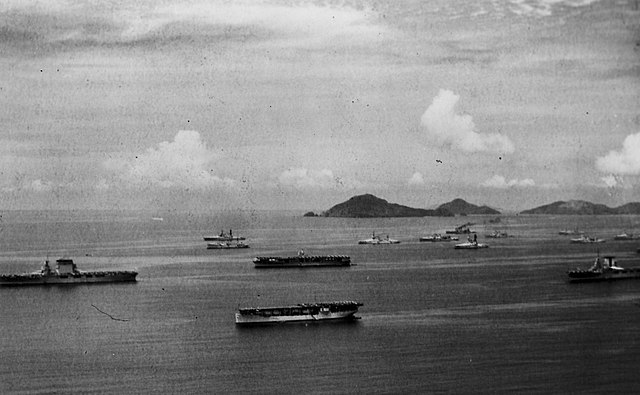
The full carrier fleet of the USN in 1936 off Panama for exercises.
USS Ranger was completed and commissioned on 4 June 1934. She conducted her initial flight operations off the Virginia Capes in June and departed Norfolk on 17 August for her shakedown cruise traveling to Rio de Janeiro, Buenos Aires, and Montevideo. She was back in the US Norfolk on 4 October, sailing to the Virginia Capes and dry docking for post-trial maintenance and fixes, until 1 April 1935. She then departed for the Pacific via the Panama Canal and arrived in San Diego on 15 April. She was stationed for about four years here, regularly participating in fleet problems from Hawaii, and in between, she became the first-ever carrier certified for operations in cold weather after her test trials in Alaska. She ventured south also down to Callao, Peru, and up to Seattle, Washington.
On January 1939, she departed San Diego for winter fleet operations in the Caribbean, from Guantánamo Bay, and returned to Norfolk on 20 April. By the fall of 1939, she started her Neutrality Patrol campaign from the Bermuda triangle and along the western trade routes up the NS Argentia in Newfoundland. In December 1940, her
fighter group VF-4 was the first to receive the brand new Grumman F4F-3 Wildcat.
Wartime career
In December 1941, she was underway to Norfolk, back from an ocean patrol reaching Port of Spain in Trinidad and Tobago. She sailed from Norfolk on 21 December, patrolling the South Atlantic, and back again in March 1942 for a refit. She was one of the first USN ships fitted with the 1st gen radar RCA CXAM-1.
Flagship, Carriers of the Atlantic fleet
She became flagship, Rear Admiral Arthur B. Cook, Carriers Commander of the Atlantic Fleet, until 6 April 1942, when replaced by Rear Admiral Ernest D. McWhorter.
Aicraft transport carrier April-May 1942
On 15 April 1942, PM Winston Churchill requested the president to send North Carolina and Ranger to reinforce the Eastern Fleet in order to bolster the RN forces bound to the Indian Ocean. The day before her planned departure, however, Admiral Ernest King denied this move to the Indian Ocean, and would only approve it under the condition that USS Ranger could ferry pursuit planes for bringing the 10th Air Force up to full operational strength first. Roosevelt backed King, but deplored his lack of tact and toned down his draft by playing up Ranger’s steering issues. Ranger, therefore, reached Naval Air Station Quonset Point, Rhode Island. There she loaded 68 Curtiss P-40Es and departed on 22 April, launching them on 10 May. They would land at Accra on the Gold Coast of Africa (Ghana). These P-40s reinforced the American Volunteer Group, the "Flying Tigers" (later 23rd Fighter Group) who were stationed in China and needed reinforcements after the heavy losses they sustained. These extra fighters would allow them to form the 51st Fighter Group. However, 10 were lost en route. Ranger was back to Quonset Point on 28 May and resumed patrols to Argentia in Newfoundland.
Plane carrier May-November 1942
By June, after the fall of Tobruk and the lost Battle of Gazala, the US agreed to support British forces more actively in the North African theater. Marshall approved the transfer of nine combat groups, seven scheduled for operation by the end of 1942. USS Ranger greatly contributed to this, ferrying 72 Army P-40s, a complete combat unit (the 57th Fighter Group), launched again off Accra on 19 July. Losses were lower due to lessons from earlier improvisations. The Group was operational with the Desert Air Force for the Second Battle of El Alamein. Ranger later stopped at Trinidad, and then Norfolk for battle practice and Bermuda with the four new Sangamon-class escort carriers.
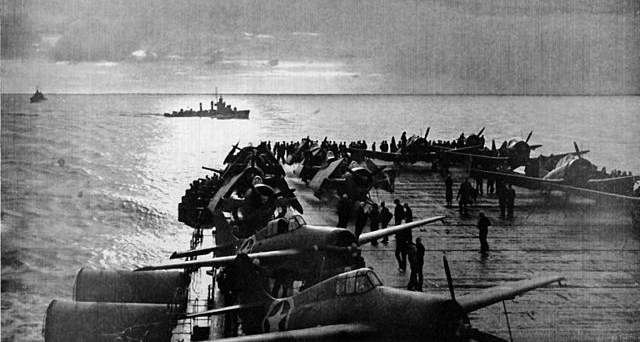
USS Ranger flight deck, Operation Torch
Operation Torch
By November 1942, USS Ranger was the largest carrier in the Atlantic Fleet and led the task force with support from the Sangamon class ships to provide air superiority during landings of Operation Torch: the takeover of Vichy-French controlled Morocco and Algeria. On 8 November 1942 landings started, and when Vichy French forces attacked the Allied forces to enforce neutrality according to the armistice conditions, Ranger participated in the Naval Battle of Casablanca.
USS Ranger by then was stationed 30 mi (48 km) northwest of Casablanca and launched her air groups to support the advancing troops on three beaches on the Atlantic coast, with nine of her Wildcat fighters attacking the Rabat and Rabat-Sale aerodromes, but also the headquarters of the French air forces in Morocco. They destroyed seven fighters and fourteen bombers on the ground, and later seven more planes on Port Lyautey airfield. Other planes strafed four French destroyers in Casablanca Harbor and destroyed shore batteries.
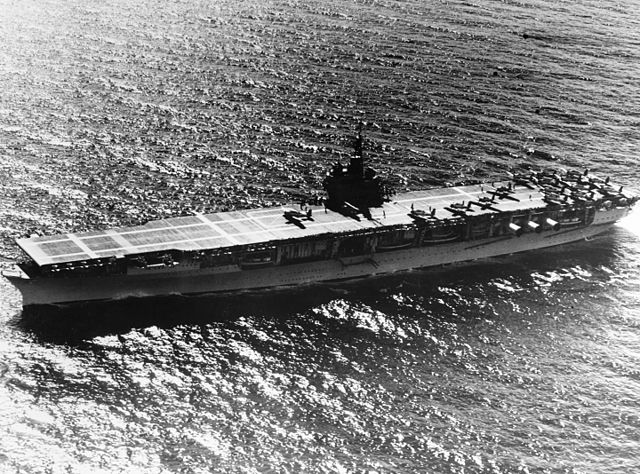
When Vichy French battleship Jean Bart opened fire on Massachusetts with her only operational turret and its four 15 in (381 mm) guns, Ranger’s dive bombers were ordered to sink or damage her. The battleship was moderately damaged at first when a bomb hit jammed the Jean Bart’s 15-in turret. But it was quickly repaired and resumed firing on 10 November. This time, the heavy cruiser Augusta was straddled (Task Force 34 flagship) and in retaliation, Ranger launched another raid. This time, Jean Bart took two heavy bombs at the bow and stern. After severe flooding, she sank into the harbor. Ranger’s planes also destroyed the French destroyer leader Albatros. Her forward half exploded, causing 300 casualties.
French cruiser Primauguet, which sortied from Casablanca and started to drop depth charges on two submarines, was also attacked. The air group also dealt with coastal defenses and anti-aircraft batteries. They made other sorties which cost the French 70 enemy aircraft on the ground, while her Wildcats claimed 15 others in aerial combat. Her dive bombers and torpedo bombers also strafed and destroyed an estimated 21 enemy light tanks and 86 military vehicles, among which were troop-carrying trucks. In all, USS Ranger made 496 combat sorties in three days, to the loss of 16 planes, with some simply being damaged beyond repair. It was an impressive tally for which she would receive a citation. Casablanca eventually capitulated on 11 November and USS Ranger departed the following day to Hampton Roads and then rallied to Norfolk on 14 December.
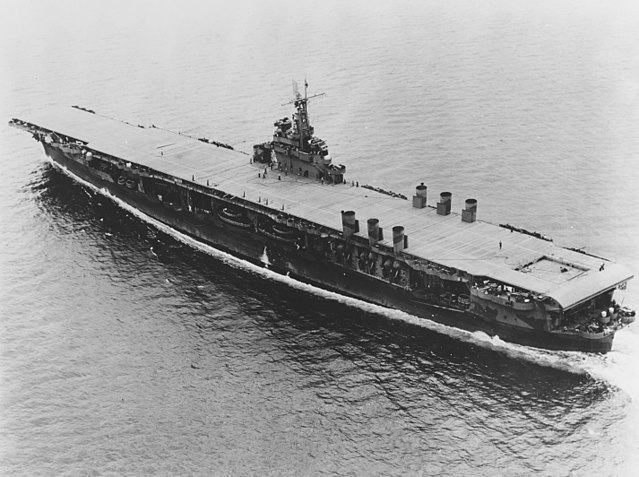
USS Ranger underway off Hampton Roads on 18 August 1942
Operations in the Atlantic, early 1943
On 2 December 1942, Churchill was cabled by Roosevelt after the loss of Hornet in the Battle of Santa Cruz Islands, seeking British carrier reinforcement. Churchill offered HMS Illustrious and Victorious, in exchange for USS Ranger replacing Victorious in the Home Fleet. King accepted Illustrious but retained Ranger to be used in the Atlantic at his discretion. Ranger trained in the Chesapeake Bay and underwent an overhaul at Norfolk NyD until February 1943. Eisenhower requested after this, that Ranger departed Norfolk on January 8th carrying 325th Fighter Group to be landed at Casablanca for replacements. Ranger made another crossing, this time with 75 P-40L fighters (58th Fighter Group), arriving on 23 February.
North sea 1943 operations
By April 1943, German radio proudly announced the Ranger had been sunk in the North Atlantic. This was supposed to have been done by Commander Otto von Bülow in U-boat U-404, which was even personally decorated by Adolf Hitler. The US Navy, knowing it was false, quickly issued a correct announcement to the families of Ranger’s crewmen. A broadcast radio denial was made on 15 February 1944 by USS Ranger’s Captain Gordon Rowe himself as the German announcement had caused some turmoil, even panic on the trade lanes to Norway where she was patrolling. After patrolling and training pilots off New England, and stopping at Halifax, Nova Scotia, Ranger departed on 11 August to join the British Home Fleet at Scapa Flow, patrolling the western approaches.
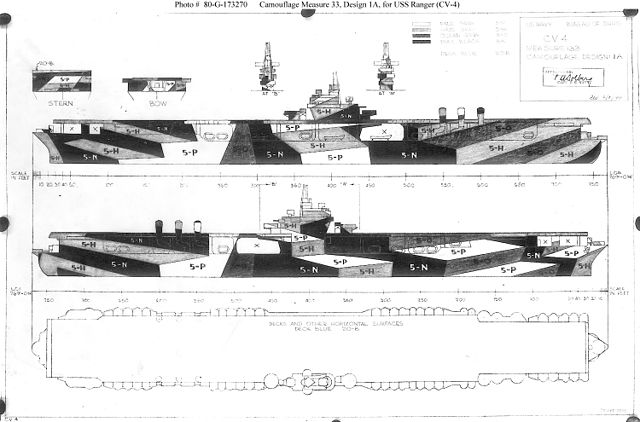
USS Ranger camouflage scheme, measure 33
She later departed from Scapa Flow on 2 October to attack German shipping in Norwegian waters, during Operation Leader. This force targeted in particular the port of Bodø and took launching positions off Vestfjorden on 4 October. Completed undetected, Ranger launched at 06:18, 20 Douglas SBD Dauntless escorted by eight Wildcats. soon the 8,000 long tons (8,100 t) freighter La Plata was spotted and sunk, followed by a German ship convoy, a 10,000 long tons (10,000 t) tanker, and a troop transport was badly damaged. Four small German merchant ships were also sunk. There was a second wave, made of 10 Grumman TBF Avengers escorted by six Wildcats. They sank a German freighter and mauled a coastal ship, along with bombing a troop transport. Three were lost in the operation to flak. On 4 October, Ranger however detected approaching planes and was indeed located by German aircraft, two being shot down in return by her Wildcats patrolling. Mission accomplished, USS Ranger was back to Scapa Flow on the 6th of October and spent the rest of the month patrolling with the British 2nd Battle Squadron. They went to Iceland, then Hvalfjord and by the fall of November, USS Ranger departed for Boston, reaching it on 3 December.
1944–1945 Operations
On 3 January 1944, USS Ranger was tasked as a training carrier. She operated from Quonset Point in Rhode Island. On 20 April, she however was rushed to Staten Island in New York, to take onboard some 76 Lockheed P-38 Lightnings with Army, Navy, and French Navy personnel to be carried to Casablanca to bolster the Free French Air Force in North Africa in preparation for operations in Italy. She departed on 24 April and arrived at Casablanca on 4 May 1944 and took onboard damaged U.S. Army aircraft to be repaired back home as well as military personnel to be landed in NyC. Afterward, she sailed to Norfolk for refit on 19 May 1944. This lasted until 11 July, after which she headed for Panama, crossed the Panama Canal, and stopped to embark army personnel at Balboa, Panama, to San Diego. She then loaded the Night Fighting Squadron 102 and around 1,000 U.S. Marines, bound to Hawaii, arriving at Pearl on 3 August. For three months, she conducted night carrier flight training operations in Hawaiian waters. She departed Pearl Harbor on 13 October to train new naval pilots to be based out of San Diego at Fleet Air Alameda in California. This activity went on until the end of the war, and she became the only carrier in the USN to never to fight Japanese forces.
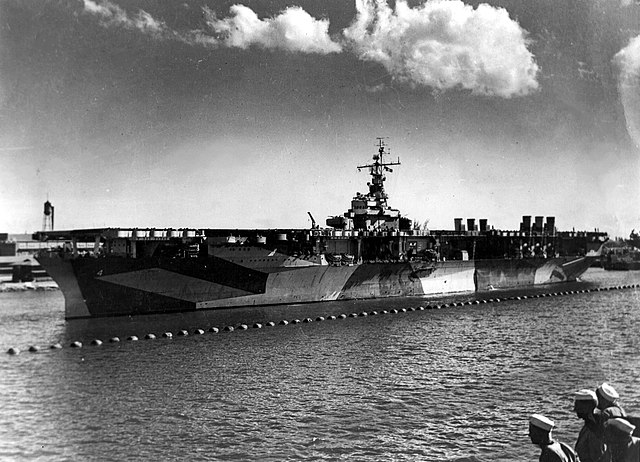
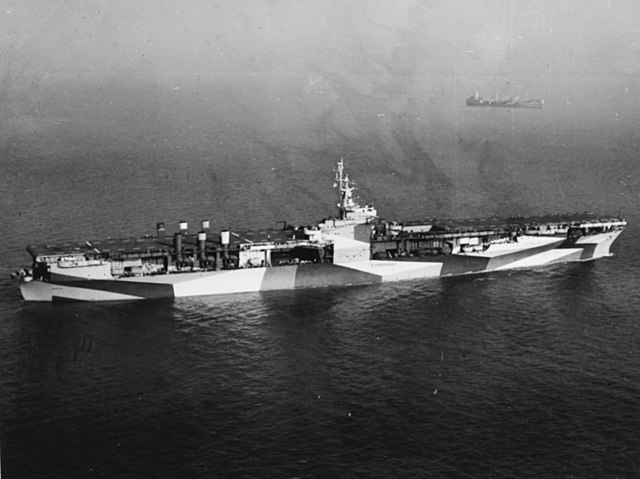
USS Ranger in June-July 1944 off Pearl Harbor, for her only deployment in the Pacific when she trained pilots for night operations.
Post war service
A cramped design by prewar standards, Ranger was of little use for any conversion and her postwar years were short. She departed San Diego on 30 September 1945 with civilian and military personnel on board taken in at Balboa and landed in New Orleans on 18 October. She participated in Navy Day celebrations and departed on 30 October to operate at Pensacola (Florida) until relieved by USS Saipan.
She stopped at Norfolk and sailed to the Philadelphia Naval Shipyard, being drydocked on 19 November, for an overhaul. After this, she resumed her training service on the eastern seaboard until her decommissioning at Norfolk NyD on 18 October 1946. She was stricken on 29 October, sold for scrap, and purchased by Sun Shipbuilding and Drydock Company based in Chester, Pennsylvania. On 31 January 1947, she departed to be broken up in their facility.
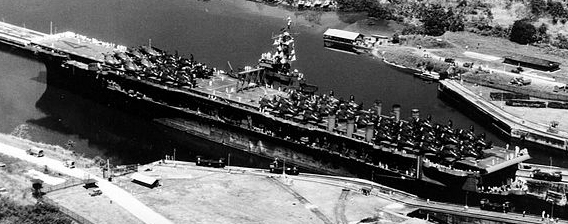
USS Ranger CV-4 in Panama Canal, 1945
Nothing survived of the Ranger. She was not the most well-known, nor the most decorated carrier in the USN, and was completely eclipsed by those that followed, like USS Wasp and the legendary Yorktown class. The fact she was too small for effective air group operations limited indeed her service and she was left completely out of the Pacific campaign for a more “cushy” Atlantic service. This was due to her design, the fruit of the 1920s reflection based on the only tailor-built designs which existed then, the British HMS Hermes and Japanese IJN Hosho. Both were based on cruiser-scale hulls designed to carry light planes. Ranger was also capped in size by experiments in light tonnage to comply with the Washington treaty limitations, and if the number of planes she could carry as delivered in 1934 was truly amazing for her size, this was no longer sufficient in 1942.
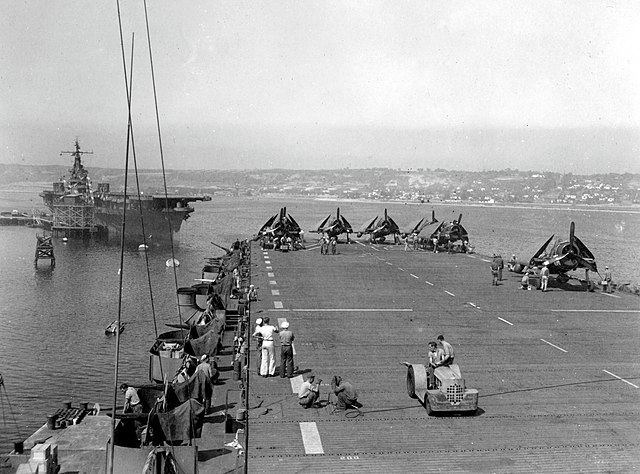
USS Ranger seen from USS Shamrock Bay at naval air station, North Island, August 1945.
USS Ranger was relatively costly to operate and maintain while being a bit slow and lightly protected, so too precious in a way to take part in convoy escorts. So she was stuck in an in-between before ending as a training carrier in 1944 and making numerous “plane taxi” missions. This was not glamorous but necessary, and sometimes decisive, like at the second battle of El Alamein. She did her duty well, and her aircrew accumulated an impressive tally, both in North Africa and in Norway, where her planes broke the back of the Vichy French Navy and German merchant traffic in northern waters, for which she received two Service stars and ribbons/awards for the American Defense Service Medal with “A” Device, American Campaign Medal, the European-African-Middle Eastern Campaign Medal with 2 stars and the Asiatic-Pacific Campaign Medal and World War II Victory Medal.
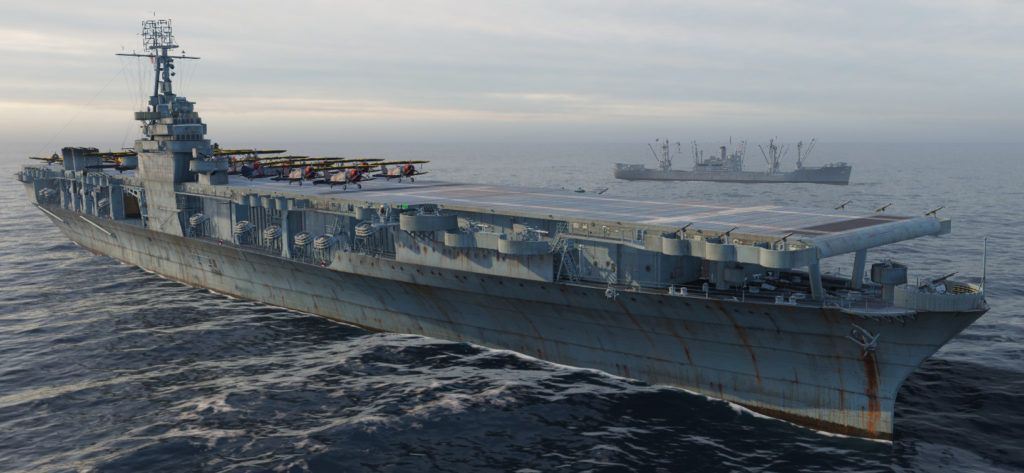

WoW’s renditions of the Ranger, with prewar planes but the 1942 radar.

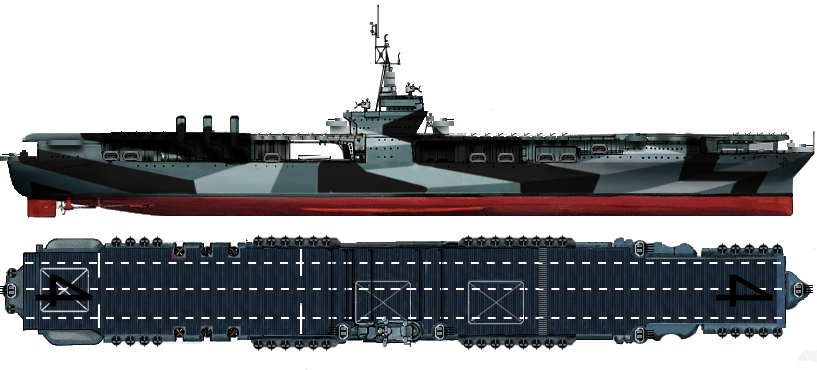
Author’s illustrations of CV-4 as completed in 1934 and in 1943.
Read More/Src
Conway’s all the world’s fighting ships 1922-1947
https://en.wikipedia.org/wiki/USS_Ranger_(CV-4)
Blair, Clay (2000). Hitler’s U-Boat War: The Hunted, 1942–1945.
Chesneau, Roger (1998). Aircraft Carriers of the World, 1914 to the Present
Cressman, Robert J. (2003). USS Ranger: The Navy’s First Flattop from Keel to Mast, 1934–1946.
Ford, Roger; Gibbons, Tony; Hewson, Rob; Jackson, Bob; Ross, David (2001). The Encyclopedia of Ships.
Friedman, Norman (1983). U.S. Aircraft Carriers: An Illustrated Design History.
Friedman, Norman (2017). Winning a Future War: War Gaming and Victory in the Pacific War.
More photos: https://commons.wikimedia.org/wiki/Category:USS_Ranger_(CV-4)
The modellers’s corner:
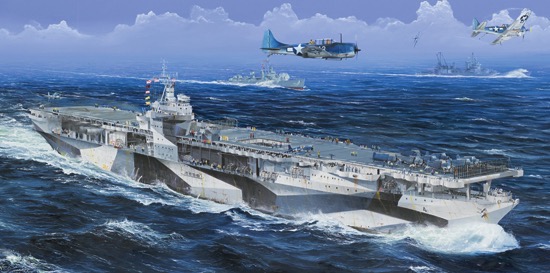
-Trumpeter 05629 Model Kit USS Ranger CV 4 1/350
-USS Ranger CV-4 Resin Model Kit Corsair Armada 1/700
-SB2U Vindicator from USS Ranger, 1/48 model kit

The USS Ranger (CV-4), an important member of the US Navy during World War II, carries a rich history and glory.
For military enthusiasts, each battleship is not only a witness to history but also a symbol worth collecting and commemorating. At this time, Custom Coins can play a role.
You can incorporate military elements related to battleships, commemorative texts, and times, etc., into the design of challenge coins. Whether it is for personal collection or as a gift for friends who also love the military, such custom challenge coins are a rare choice.


 Latest Facebook Entry -
Latest Facebook Entry -  X(Tweeter) Naval Encyclopedia's deck archive
X(Tweeter) Naval Encyclopedia's deck archive Instagram (@navalencyc)
Instagram (@navalencyc)





 French Navy
French Navy Royal Navy
Royal Navy Russian Navy
Russian Navy Armada Espanola
Armada Espanola Austrian Navy
Austrian Navy K.u.K. Kriegsmarine
K.u.K. Kriegsmarine Dansk Marine
Dansk Marine Nautiko Hellenon
Nautiko Hellenon Koninklije Marine 1870
Koninklije Marine 1870 Marinha do Brasil
Marinha do Brasil Osmanlı Donanması
Osmanlı Donanması Marina Do Peru
Marina Do Peru Marinha do Portugal
Marinha do Portugal Regia Marina 1870
Regia Marina 1870 Nihhon Kaigun 1870
Nihhon Kaigun 1870 Preußische Marine 1870
Preußische Marine 1870 Russkiy Flot 1870
Russkiy Flot 1870 Svenska marinen
Svenska marinen Søværnet
Søværnet Union Navy
Union Navy Confederate Navy
Confederate Navy Armada de Argentina
Armada de Argentina Imperial Chinese Navy
Imperial Chinese Navy Marinha do Portugal
Marinha do Portugal Mexico
Mexico Kaiserliche Marine
Kaiserliche Marine 1898 US Navy
1898 US Navy Sovietskiy Flot
Sovietskiy Flot Royal Canadian Navy
Royal Canadian Navy Royal Australian Navy
Royal Australian Navy RNZN Fleet
RNZN Fleet Chinese Navy 1937
Chinese Navy 1937 Kriegsmarine
Kriegsmarine Chilean Navy
Chilean Navy Danish Navy
Danish Navy Finnish Navy
Finnish Navy Hellenic Navy
Hellenic Navy Polish Navy
Polish Navy Romanian Navy
Romanian Navy Turkish Navy
Turkish Navy Royal Yugoslav Navy
Royal Yugoslav Navy Royal Thai Navy
Royal Thai Navy Minor Navies
Minor Navies Albania
Albania Austria
Austria Belgium
Belgium Columbia
Columbia Costa Rica
Costa Rica Cuba
Cuba Czechoslovakia
Czechoslovakia Dominican Republic
Dominican Republic Haiti
Haiti Hungary
Hungary Honduras
Honduras Estonia
Estonia Iceland
Iceland Eire
Eire Equador
Equador Iran
Iran Iraq
Iraq Latvia
Latvia Liberia
Liberia Lithuania
Lithuania Mandchukuo
Mandchukuo Morocco
Morocco Nicaragua
Nicaragua Persia
Persia San Salvador
San Salvador Sarawak
Sarawak Uruguay
Uruguay Venezuela
Venezuela Zanzibar
Zanzibar Warsaw Pact Navies
Warsaw Pact Navies Bulgaria
Bulgaria Hungary
Hungary

 Bundesmarine
Bundesmarine Dutch Navy
Dutch Navy Hellenic Navy
Hellenic Navy Marina Militare
Marina Militare Yugoslav Navy
Yugoslav Navy Chinese Navy
Chinese Navy Indian Navy
Indian Navy Indonesian Navy
Indonesian Navy JMSDF
JMSDF North Korean Navy
North Korean Navy Pakistani Navy
Pakistani Navy Philippines Navy
Philippines Navy ROKN
ROKN Rep. of Singapore Navy
Rep. of Singapore Navy Taiwanese Navy
Taiwanese Navy IDF Navy
IDF Navy Saudi Navy
Saudi Navy Royal New Zealand Navy
Royal New Zealand Navy Egyptian Navy
Egyptian Navy South African Navy
South African Navy






























 Ukrainian Navy
Ukrainian Navy dbodesign
dbodesign